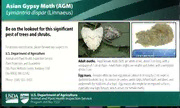
Asian gypsy moth (AGM) Lymantria dispar (Linnaeus) PDF
Preview Asian gypsy moth (AGM) Lymantria dispar (Linnaeus)
Historic, Archive Document Do not assume content reflects current scientific knowledge, policies, or practices. Be on the lookout for this significant pest of trees and shrubs. For positive identification, please forward any suspects to: U.S. Department of Agriculture Animal and Plant Health Inspection Service Adult moths. Adult female AGMs (left) are white or tan, about 3 cm long, with a Plant Protection and Quarantine wingspan of 7 cm or more. Adult males (right) are smaller and darker, with a wingspan Otis Plant Methods Center, Building 1398 of4to5cm. Otis ANGB, MA 02542 Egg mass. Females often lay their egg masses (about 4 cm long by 2 cm wide) in Phone:(508)563-9303 sheltered locations (e.g., in crevices or cavities, under tarps, behind walls and doors, and underneath the hold rims of a ship). Egg masses also might be on exposed surfaces, especially near light fixtures, which attract the female moths. USDA APHIS U.S. Department of Agriculture -Animal and Plant Health Inspecti Service Program Aid No. 1537 First- (top) and fourth-instar larvae. When AGM eggs hatch during warm weather, the insects emerge as caterpillars and grow through several life stages called instars. Note how much the caterpillars grow between the first and the penultimate (fourth) instar. These larvae climb rapidly, and the smallest instars could be transported from the ship by blowing silk strands. Pupa. After AGM larvae reach the fifth instar, they pass into the pupal stage, when they develop into an adult moth inside a hard pupal case. This stage typically occurs in the spring or summer. Pupal cases can be attached to exposed surfaces or concealed in sheltered spaces. Revised December 2007 The US. Department of Agriculture is an equal opportunity provider and employer.
